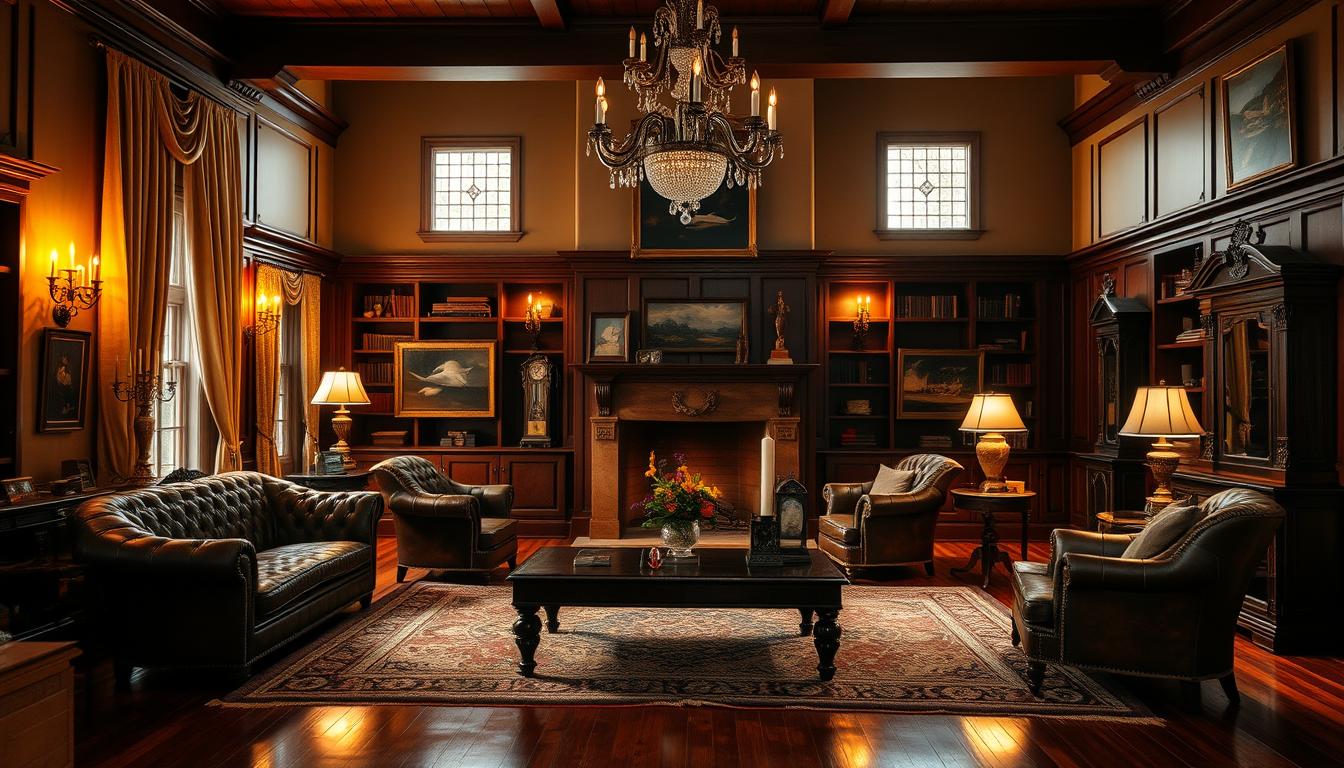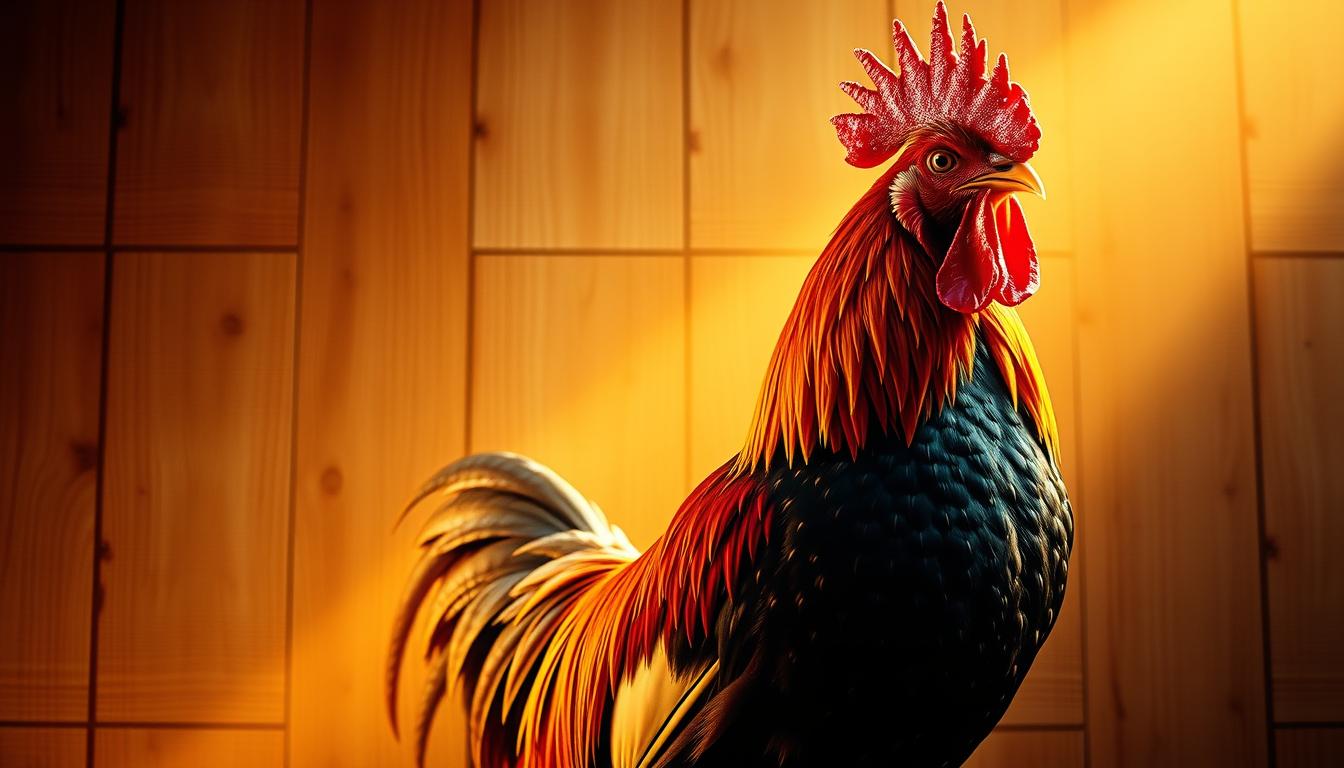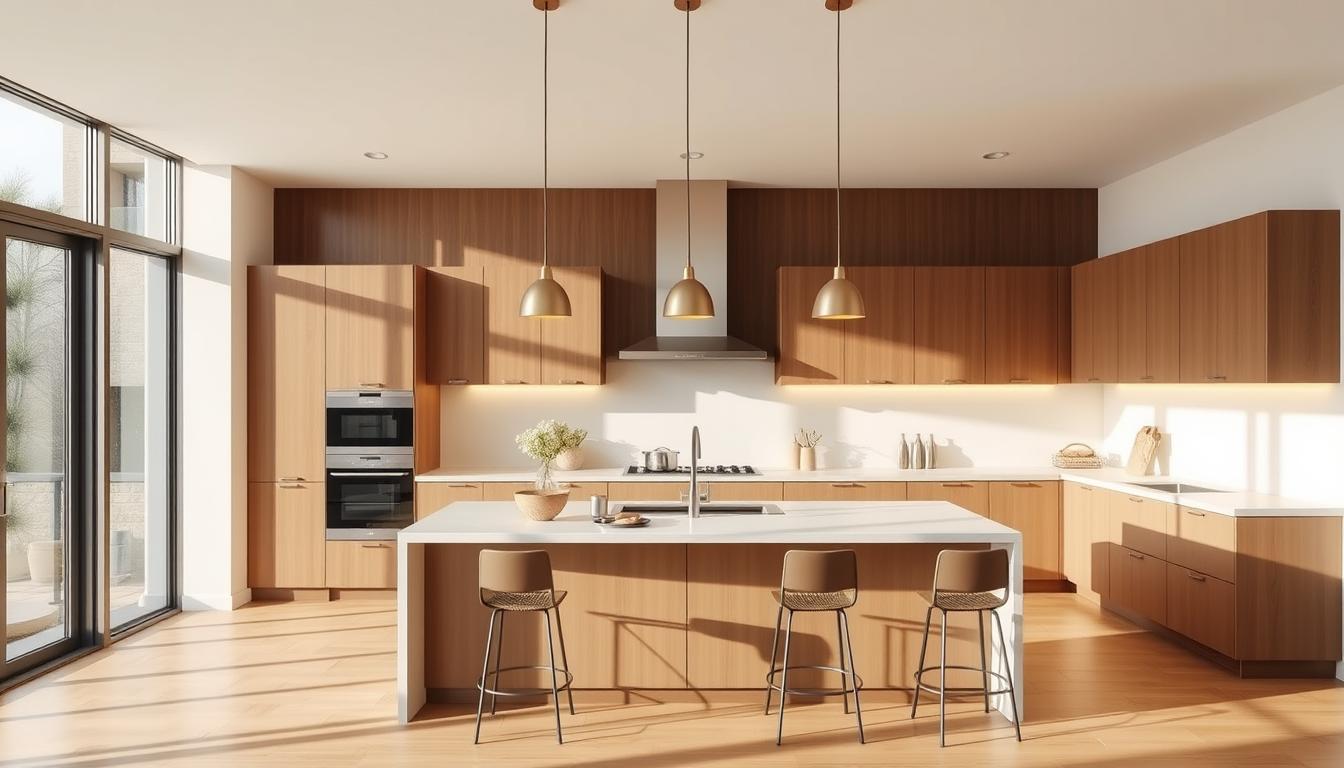For centuries, Colonial-style interiors have won hearts with their mix of simplicity and elegance. This timeless look, rooted in tradition and practicality, brings warmth and authenticity to any room. It’s a classic choice for those who love a traditional feel.
We’ll show you the key elements and decor tips that make Colonial-style interiors so iconic. You’ll learn how to create a home that’s both stunning and welcoming. By diving into the history and key features of this design, you’ll know how to add the essential touches for an authentic look.
Key Takeaways
- Understanding the history and characteristics of Colonial design.
- Identifying essential elements that define Colonial-style interiors.
- Applying decor tips for an authentic Colonial look.
- Creating a welcoming and beautiful home with Colonial style furniture.
- Balancing simplicity and elegance in your interior design.
Understanding Colonial Style Homes
Knowing the history of Colonial architecture helps us appreciate its design. Colonial homes have a rich history tied to the culture and geography of the United States.
Historical Background of Colonial Architecture
Colonial architecture in the United States shows the country’s colonial past. It was influenced by European styles. Different Colonial home styles emerged based on their region’s culture, society, and geography.
The Georgian style is known for its symmetry and classical details. The Dutch Colonial style is famous for its gambrel roofs.
Some notable Colonial home styles include:
- Georgian Colonial: Known for its balanced facade and classical elements.
- Federal Style: Characterized by its neoclassical details and refined proportions.
- Dutch Colonial: Recognizable by its gambrel roof and often, a more rustic charm.
Key Characteristics of Colonial Homes
Colonial homes have distinct architectural features. These include:
- Symmetry: Many Colonial homes have a symmetrical facade, making them look classic and balanced.
- Classical Details: Elements like columns, pilasters, and pediments are common, showing European influences.
- Traditional Materials: Colonial homes often use traditional materials like brick, wood, and stone, adding to their historic charm.
Understanding these historical and architectural elements helps us appreciate Colonial style homes. It allows homeowners and designers to create spaces that are authentic and welcoming.
Essential Elements of Colonial Interior Design
Colonial interiors are known for their warm, inviting feel. This is thanks to classic color palettes and authentic materials. These elements make a space cozy and welcoming, blending classic comfort.
To design a Colonial-style interior, understanding its history and key features is crucial. Colonial decorating style is deeply rooted in tradition. By using its essential elements, you can make a home that’s both elegant and lived-in.
Color Palettes that Reflect Colonial Style
Classic color palettes are a key part of Colonial interior design. These palettes often include light neutrals and whites. These colors reflect the past and cool down warm spaces, creating a calm and serene atmosphere.
Common colors in Colonial interiors include:
- Soft whites and creams
- Mellow wood tones
- Muted earth tones
- Rich blues and reds
These colors can be used on walls, furniture, and textiles for a cohesive look. For instance, a soft white on walls can pair well with mellow wood tones on furniture. This creates a harmonious and inviting atmosphere.
“The right color palette can transform a room, making it feel more spacious, more welcoming, and more in tune with the Colonial style.”
Common Materials Used in Colonial Interiors
Natural materials are essential in Colonial design, adding warmth and texture. Wood, in particular, is a key material, used for furniture, flooring, and paneling. Other natural materials like stone, brick, and linen are also common.
| Material | Common Uses |
|---|---|
| Wood | Furniture, flooring, paneling |
| Stone | Fireplaces, flooring |
| Brick | Walls, fireplaces |
| Linen | Textiles, upholstery |
Using these materials in your design can create a warm and inviting space. It will feel authentic to the Colonial style.
Furniture Choices for a Colonial Home
The furniture in a Colonial home is more than just useful. It shows off the era’s skill and taste in design. When picking furniture for a Colonial home, choose pieces that match the style’s historical feel.
Traditional Furniture Styles and Designs
Colonial style furniture is known for being simple, strong, and classic. Some common styles include:
- Queen Anne: Known for its elegant curves and refined details.
- Chippendale: Characterized by intricate carvings and a mix of Gothic and Chinese influences.
- Georgian: Features classical motifs and a sense of grandeur.
These styles are not just pretty. They also tell a story of the time they were made. Adding these pieces to your home can make it feel more real and authentic.
Tips for Selecting Authentic Colonial Pieces
When picking furniture for a Colonial home, look for pieces that are real to the time or very close copies. Here are some tips:
- Look for solid wood construction, as it was the primary material used in Colonial furniture making.
- Pay attention to details such as carvings, moldings, and hardware, as these can be indicative of the piece’s era.
- Consider the scale of the furniture in relation to your rooms. Large, imposing pieces were common in Colonial homes.
Choosing furniture that fits Colonial style principles can make your home look and feel right. Whether you have real antiques or high-quality copies, the right furniture will make your Colonial home more charming and unique.
Interior design experts say, “The key to successful Colonial décor is in the details and the commitment to authenticity.” This way, you honor the style’s history and create a space that is both lovely and full of meaning.
“Furniture is the backbone of any interior design, and in Colonial homes, it plays a critical role in defining the space’s character and ambiance.”
Architectural Features to Incorporate
To make a Colonial interior, knowing the key architectural elements is crucial. Colonial homes are known for their timeless beauty. This beauty comes from their unique architectural features.
Door and Window Styles in Colonial Interiors
Doors and windows are key in defining Colonial style. Traditional Colonial homes have multi-paned windows and a central front door with a pediment. These features enhance the look and add to the Colonial design’s authenticity.
The right door and window styles are vital for your Colonial home’s look. For example, double-hung windows with multiple panes give a classic and elegant look.
| Feature | Description | Colonial Style Significance |
|---|---|---|
| Multi-paned Windows | Windows with multiple panes, often double-hung | Adds to the classic and timeless appeal |
| Central Front Door with Pediment | A central front door accompanied by a pediment | Contributes to the symmetry and elegance of the facade |
| Decorative Cornices | Moldings that crown or top a door or window | Enhances the interior and exterior architectural detail |
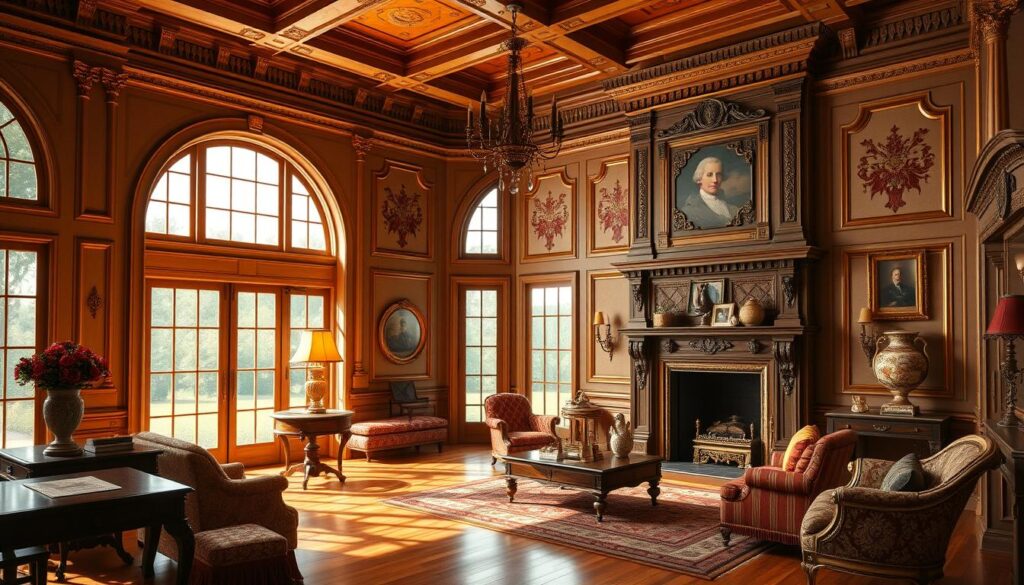
Fireplaces and Mantels: A Focal Point
Fireplaces and mantels are central in Colonial homes. They serve both function and beauty. A well-designed fireplace can be the room’s centerpiece, adding warmth and character.
When picking a fireplace and mantel, stick to Colonial style and materials. Traditional materials like wood and stone bring authenticity to your Colonial interior.
- Choose materials and designs that are consistent with Colonial architecture.
- Consider the scale and proportion of the fireplace in relation to the room.
- Pay attention to the detailing on the mantel, as it can significantly impact the overall aesthetic.
Textiles and Fabrics in Colonial Decor
Colonial interiors were warm and textured thanks to natural fibers. The Colonial era favored materials like cotton, wool, and linen. These were durable and showed the era’s simplicity and practicality.
Choosing Period-Appropriate Textiles
When picking textiles for a Colonial-style home, choose materials from that time. Cotton, linen, and wool were key, often in natural colors or soft dyes. For a real look, go for fabrics with stripes, florals, and geometrics.
Stores like Suzie Anderson Home offer inspiration and resources for vintage colonial décor. They help you find the right fit for your traditional home décor.
Layering Fabrics for Depth and Warmth
Layering fabrics was a key practice in Colonial interiors. It added both function and beauty. It made rooms cozy by adding depth and warmth.
Begin with basic linens and cottons for bedding and curtains. Then, add woolen throws and blankets for warmth. This layering boosts comfort and looks great, making it a core part of colonial design.
To create a cozy feel, mix different textures and patterns. For example, pair smooth cotton with wool or linen for contrast. Also, layering sheer fabrics under heavier drapery adds a soft, inviting glow. This enhances the cozy atmosphere.
Lighting Choices in Colonial Homes
Choosing the right lighting is key to a cozy colonial interior. Lighting can change how a room feels, making it more open, cozy, or inviting. In colonial homes, lights are not just for seeing; they also add to the room’s look.
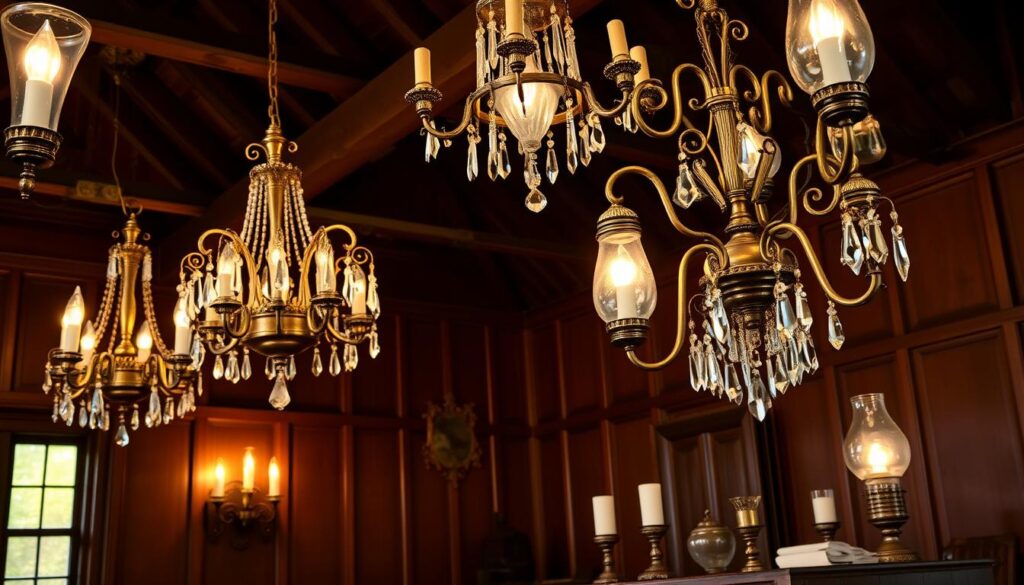
Types of Lighting Fixtures to Consider
Traditional lights like cast-iron lamps, chandeliers, and candle holders fit well with Colonial decor. These lights do more than just light up a room. They also decorate it, adding to the colonial feel. For example, chandeliers with bulb shapes like candles can make dining rooms feel more authentic.
Think about your home’s style and era when picking lights. Even in modern colonial homes, you can find lights that still look traditional.
Creating a Cozy Ambiance with Light
To make a room cozy, use different types of lighting. Mix overhead lights, table lamps, and floor lamps for a warm feel. Layered lighting lets you change the light levels for different times and activities.
Candles and fireplaces also add to the cozy feel in colonial homes. The soft light from candles and the warmth of a fire make rooms feel more welcoming.
By carefully choosing and layering your lighting, you can make your colonial home feel cozy and inviting. Whether you want a traditional look or something more modern, the right lights can make a big difference.
Wall Treatments and Finishes
The walls of a Colonial home are more than just a backdrop. They are a canvas that shows the style and sophistication of the era. Choosing the right wall treatments and finishes is key to creating an authentic and inviting atmosphere.
Colonial interiors often used subtle, earthy tones. Soft whites and creams were very popular. These colors added warmth and helped tie the home together.
Paint vs. Wallpaper: What Works Best?
Colonial homeowners had two main choices for wall treatments: paint and wallpaper. Both can help achieve a traditional look.
- Paint: Offers a clean, classic look and can be updated with new colors. It’s great for a uniform look throughout the home.
- Wallpaper: Adds texture and pattern, making a room lively. Classic designs can enhance the Colonial look.
The choice between paint and wallpaper depends on the look you want and the room’s purpose. For example, a formal room might look better with wallpaper, while a simpler space could be updated with paint.
Authentic Choices for Wall Coverings
For those wanting to stick to Colonial design, there are several authentic wall covering options:
- Historic Colors: Using paint colors from the Colonial era adds authenticity to your home’s décor.
- Traditional Patterns: Wallpapers with classic patterns like stripes, florals, and geometrics were common in Colonial design.
- Natural Materials: Adding natural materials like wood paneling or wainscoting can also enhance the Colonial look.
By choosing the right wall treatments and finishes, homeowners can create a beautiful and historically respectful Colonial interior.
Accessorizing Your Colonial Interior
To make your Colonial interior unique and welcoming, accessorizing is key. Accessories blend modern touches with Colonial design, making your home special.
Selecting Artwork and Decorative Pieces
Artwork and decorative pieces can greatly enhance your Colonial home’s look. Choose items that show off the traditional Colonial style but also have a modern twist. For example, vintage pieces can go well with modern art for a nice contrast.
- Choose artwork that complements your Colonial home’s color palette.
- Opt for decorative pieces that reflect the era, such as antique vases or traditional colonial style furniture.
- Add modern elements, like abstract art or contemporary lighting, to bring in a modern touch.
Incorporating Period Accessories and Accents
Adding period accessories and accents is crucial for keeping your Colonial interior authentic. These can include vintage rugs, antique furniture, and traditional textiles. It’s important to find a balance; too much modern can lose the Colonial charm, while too much vintage can make it feel old.
To get the right balance, follow these tips:
- Begin with a few standout pieces, like a vintage rug or an antique side table, and then add more.
- Combine traditional home décor with modern accents for a unique look.
- Make sure your accessories are the right size and fit well in the space.
By carefully choosing accessories for your Colonial interior, you can create a space that feels both authentic and inviting. Whether you prefer vintage colonial décor or modern takes on traditional styles, the right accessories can truly enhance decorating colonial homes effectively.
Landscaping to Complement Colonial Design
To make a Colonial home look welcoming, the landscaping should match its traditional style. A neat lawn and the right garden can really boost the home’s look.
Garden Styles that Pair Well with Colonial Homes
Colonial homes often have gardens that are neat and symmetrical. This shows the orderly, classic feel of Colonial architecture. Traditional garden styles like English or French gardens are great because they match the home’s classic lines.
Choose plants that were popular back then, like boxwood, hydrangeas, and roses. These plants add to the garden’s historical charm and make it look beautiful and timeless.
Outdoor Living Spaces in Colonial Style
Outdoor areas can be designed to match the elegance of Colonial interiors. Use materials like brick, stone, or wood for patios and walkways. This makes the indoor and outdoor spaces feel connected.
Furniture and decor for outdoor areas should also be Colonial-style. Look for sturdy, classic, and comfy pieces. Add things like lanterns, planters, and outdoor heaters to make the space cozy and inviting.
By planning the landscaping and outdoor areas well, homeowners can make their Colonial homes even more beautiful. This creates a welcoming exterior that matches the home’s interior design.
Tips for Modernizing Colonial Interiors
Modernizing a Colonial home is all about finding the right mix. You need to keep its charm while adding new touches. The secret is to merge old and new beautifully.
Blending Contemporary Elements with Tradition
To update your Colonial home, think about adding modern furniture that fits its style. For example, a sleek sofa can go well with traditional armchairs. Modern lighting, like pendant lights, can also add a stylish touch.
When picking modern items, make sure they match the Colonial look. Look for furniture with simple designs and bold colors. Adding modern textiles, like patterned rugs, can also make your space pop.
| Element | Traditional | Contemporary |
|---|---|---|
| Furniture | Ornate carvings, intricate details | Clean lines, minimal ornamentation |
| Lighting | Candelabras, traditional chandeliers | Pendant lights, sconces |
| Textiles | Muted colors, classic patterns | Bold patterns, vibrant colors |
Maintaining Authenticity While Updating
When you modernize your Colonial home, keep its true spirit alive. Save its original features like crown molding and fireplaces. Use traditional materials like wood in your updates.
For more ideas on designing a Colonial home, check out our guide. It’s full of design tips and inspiration.
To keep your home’s essence, follow these tips:
- Save original architectural features whenever you can.
- Use traditional materials in your updates.
- Choose modern pieces that match the Colonial style.
Resources for Colonial Home Inspiration
Looking to bring a Colonial-style interior into your home? There are many resources to help. You can find books and magazines that focus on Colonial design.
Publications on Colonial Design
“The Colonial House” book and magazines like “Traditional Home” and “Colonial Homes” are great. They’re full of ideas for colonial interiors and traditional decor. You’ll also learn about the history of Colonial architecture.
Using these resources, you can learn more about Colonial-style homes. You can even mix old and new styles in your home. Whether you want a classic look or something modern, these resources can guide you.

